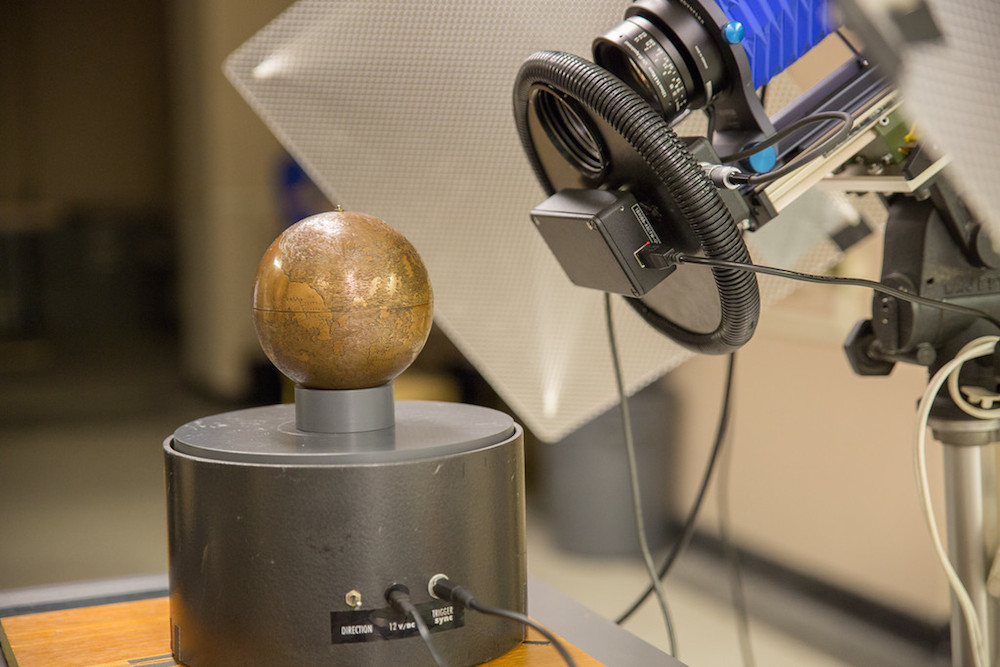Treasured 16th-Century 'Lenox Globe' Gets a Digital Makeover

NEW YORK — In a dark room at the New York Public Library, a cartographer, a curator of rare books and a handful of scientists crowded around a camera ringed by colored lights. All eyes were trained on a small, copper sphere about the size of a grapefruit: the Lenox Globe, the oldest surviving globe to depict the New World.
By imaging the globe from top to bottom and conducting a 3D scan of it, the researchers plan to provide a precise digital record of the object that will last for generations, giving scholars and members of the public a glimpse at what people knew about world geography in the early 1500s.
Chet Van Duzer, a cartographer currently based at the Library of Congress in Washington, D.C., is leading the effort to image the ancient orb. [Photos: 'Lenox Globe' Is Oldest to Show the Americas]
"It's the first globe with a record of the New World, it's pretty widely agreed [upon]," Van Duzer told Live Science. The orb only depicts the continent of South America, though the existence of North America was known at least in some circles, Van Duzer said.
A masterpiece of workmanship, the Lenox Globe measures 4.4 inches across (11.2 centimeters), and the hollow copper sphere is engraved with almost microscopic detail. The globe's maker is unknown and its age is disputed, but based on the geography it depicts, some historians say the object was likely made between 1503 and 1507.
A rainbow of imaging
To capture the globe in digital form, the team used a method that involves imaging the object in a variety of different colors, or wavelengths. The technique, known as multispectral imaging, captures the object's color most faithfully, and provides a complete record of it, Van Duzer said.
Get the world’s most fascinating discoveries delivered straight to your inbox.
The researchers took 18 pictures around the globe's equator, 39 images at various latitudes and one of the pole; then, they repeated the process for the Southern Hemisphere. Different colored lights were used to capture the images at different wavelengths, including ultraviolet, which is powerful enough to damage your eyes if you don't shield them, the researchers cautioned.
The imaging was done in conjunction with the Lazarus Project, an organization that provides access to advanced imaging technology to historical researchers.
"We provide multispectral imaging and 3D imaging for cultural heritage of objects, financed through charity," said Gregory Hayworth, director of the Lazarus Project and an English professor at the University of Mississippi, in Oxford. [Images: Oldest Globe Showing New World]
But imaging a curved surface isn't easy. "You need to have a flat field, otherwise the play of light will alter the color, and it will alter the geometry," Hayworth told Live Science. Because the globe is made of metal, it disperses light — "it's like taking a photograph of a mirror," so capturing the globe's true colors is difficult, he said.
Although the globe looks spherical, it's not perfect, which can cause distortion in the 3D digital replica. So, after taking the high-resolution color images, the researchers made 3D scans of the globe. By wrapping the 2D multispectral images around the 3D scan, they can get a much more accurate reconstruction of the globe, Hayworth said.
History of the globe
Not much was known about the Lenox Globe until 1850, when an architect named Richard Morris Hunt purchased the globe at a flea market in Paris, according to Michael Inman, curator of rare books at the New York Public Library. In the 1860s, Henry Stevens, an agent for the New York City rare book collector James Lenox, was visiting Hunt when he noticed Hunt's children rolling a small copper sphere around on the floor. Stevens asked Hunt if he could borrow the globe and examine it.
Upon finding out it was the oldest known terrestrial globe to depict the Americas, Hunt donated the globe to the Lenox Library, which is now part of the New York Public Library. It's been there ever since.
The Library declined to comment on the globe's value.
A globe very similar to the Lenox Globe exists in Poland, and is thought to be from the same maker, Van Duzer said. Known as the Jagiellonian Globe, the Polish orb dates from around 1510 and is part of an astronomical clock at Jagiellonian University in Krakow, Poland. One major difference between the globes is that the Jagiellonian Globe depicts an island in the South Pacific wrongly labeled "America novitert reperta" (America, newly discovered).
The researchers hope that creating a digital replica of the Lenox Globe will make it accessible to generations of scholars and the public.
Today's historians don't know the answer to the question, 'What did the globe look like 300 years ago?' said imaging scientist Ken Boydston, president of the company Megavision, which makes equipment for the Lazarus Project. "But in the future, they can ask that question, and they will know."
Editor's Note: This article was updated at 11:48 a.m. ET Jan. 14, to correct a quote by Michaethat was wrongly attributed.
Follow Tanya Lewis on Twitter. Follow us @livescience, Facebook & Google+. Original article on Live Science.



